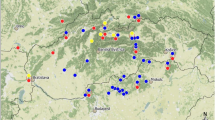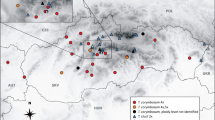Abstract
Eryngium duriaei (Apiaceae) is an endemic taxa from Iberian Peninsula. Some doubts exist in the literature about the taxa relationships, especially among Iberian populations at different altitudes. Also, as other Apiaceae, this species presents a large potential for essential oil production. Considering all this, a multidisciplinary study comprising taxonomic, cytological (using flow cytometry and chromosome counts) and chemical (essential oils) analyses was performed with the objective to morphologically characterize this species and to evaluate the cytotaxonomical and chemical diversity of E. duriaei Portuguese populations. FCM and chromosome counts have shown that every individual presented the same ploidy level, i.e., 2n = 2x = 16 chromosomes. However, flow cytometric analyses revealed that individuals of E. duriaei from higher altitudes (»1,700 m) presented a significantly higher genome size than those belonging to E. duriaei populations below 1,700 m (2C = 6.20 ± 0.04 vs. 2C = 5.52 ± 0.05 pg). Moreover, the essential oils analyses revealed that most chemical constituents were sesquiterpenes, but relevant differences in the main components were observed: α-neocallitropsene (28–53 %), β-betulenal (8.5–15.8 %) and 14-hydroxy-β-caryophyllene (5.8–13.7 %) were the main compounds of Eryngium duriaei oil below 1,700 m, whereas caryophyllene oxide (47 %) and E-caryophyllene (6 %) were the major compounds of E. duriaei oil of higher altitude populations. The results provide important evidences to support the taxonomic separation of E. duriaei in two taxa: E. duriaei J. Gay ex Boiss. subsp. duriaei and E. duriaei subsp. juresianum (M. Laínz) M. Laínz, as previously considered by this author.




Similar content being viewed by others
References
Adams RP (1995) Identification of essential oils components by gas chromatography/quadrupole mass spectroscopy. Allured Publ Corp, Carol Stream
Ayoub N, Kubeczka KH, Nawwar MAM (2003) An unique n-propyl sesquiterpene from Eryngium creticum L. (Apiaceae). Pharmazie 58:674–676
Ayoub N, Al-Aziz M, Koning W, Kubeczka KH (2006) Essential oils and a novel polyacetylene from Eryngium yuccifolium Michaux. (Apiaceae). Flavour Fragr J 21:864–868
Bennett MD, Leitch IJ (2005) Genome size evolution in plants. In: Gregory T (ed) The evolution of the genome. Elsevier Academic Press, Amsterdam, pp 89–162
Berenbaum MR (2001) Chemical mediation of coevolution: phylogenetic evidence for Apiaceae and associates. Ann Mo Bot Gard 88:45–59
Bylebyl K, Poschlod P, Reisch C (2008) Genetic variation of Eryngium campestre L. (Apiaceae) in Central Europe. Mol Ecol 17:3379–3388
Calviño C, Martínez S, Downie S (2008) The evolutionary history of Eryngium (Apiaceae, Saniculoideae): rapid radiations, long distance dispersals, and hybridizations. Mol Phylogenet Evol 46:1129–1150
Calviño C, Martínez S, Downie S (2010) Unraveling the taxonomic complexity of Eryngium L. (Apiaceae, Saniculoideae): phylogenetic analysis of 11 non-coding cpDNA loci corroborates rapid radiations. Plant Div Evol 128:137–149
Capetanos C, Saroglou V, Marin PD, Simi A, Skalsai HD (2007) Essential oil analysis of two endemic Eryngium species from Serbia. J Serb Chem Soc 72:961–965
Castroviejo S, Laínz M, López González G, Montserrat P, Muñoz Garmendia F, Paiva J, Villar L (eds) (2003) Flora Ibérica, Plantas vasculares de la Península Ibérica, e Islas Baleares, vol X. Araliaceae-Umbelliferae. Real Jardín Botánico, C.S.I.C. Madrid
Cavaleiro C, Gonçalves MJ, Serra D, Santoro G, Tomi F, Bighelli A, Salgueiro L, Casanova J (2011) Composition of a volatile extract of Eryngium duriaei subsp. juresianum (M. Laínz) M. Laínz, signalised by the antifungal activity. J Pharm Biomed Anal 54:619–622
Darlington CD, La Cour LF (1976) The handling of chromosomes, 6th edn. George Allen & Unwin Ltd, London
Darriet F, Bendahou M, Desjobert JM, Costa J, Muselli A (2012) Bicyclo (4.4.0)decane oxygenated sesquiterpenes from Eryngium maritimum essential oil. Planta Med 78:386–389
Fidelis A, Gerhard A, Overbeck A, DePatta VP, Pfadenhauer J (2008) Effects of disturbance on population biology of the rosette species Eryngium horridum Malme in grasslands in southern Brazil. Plant Ecol 195:55–67
Gimenez E, Melendo M, Valle F, Gómez-Mercado F, Cano E (2004) Endemic flora biodiversity in the south of the Iberian Peninsula: altitudinal distribution, life forms and dispersal modes. Biodivers Conserv 13:2641–2660
Gonçalves MJ, Cruz MT, Tavares AC, Cavaleiro C, Lopes M, Canhoto JM, Salgueiro L (2012a) Composition and biological activity of the essential oil from Thapsia minor, a new source of geranyl acetate. Ind Crops Prod 35:166–171
Gonçalves MJ, Tavares AC, Cavaleiro C, Cruz MT, Lopes MC, Canhoto JM, Salgueiro L (2012b) Composition, antifungal activity and cytotoxicity of Seseli tortuosum L. and Seseli montanum subsp. peixotoanum (Samp.) M. Lainz from Portugal. Ind Crops Prod 39:204–209
Hawkins B, Sharrock S, Havens K (2008) Plants and climate changes: which future? Botanic Gardens Conservation International, Richmond
Jansen J (1998) Übersicht der Silikatschuttvegetation in den höheren Stufen der Serra da Estrela, Portugal. Ber D Reinh Tuxen-Ges 10:95–124
Jansen J, van der Knapp WO, Paiva J (2000) A short note on plant taxa from the Serra da Estrela new to Portugal. Silva Lusitana 7:287–289
Joulain D, Konig WA (1998) The Atlas of spectral data of sesquiterpene hydrocarbon. B. Verlag Hamburg, Hamburg
Laínz M (1965) Aportaciones al conocimiento de la flora gallega IV, Anales Inst. Florest Invest 10:299–332
Laínz M (1967) Aportaciones al conocimiento de la flora gallega V, Anales Inst. Florest Invest 34:1–51
Laínz M (1969) Floram europaeam animadversiones. Candollea 24:253–262
Leong-Skornickova J, Sida O, Jarolimova V, Sabu M, Fer T, Travnicek P, Suda J (2007) Chromosome numbers and genome size variation in Indian species of Curcuma (Zingiberaceae). Ann Bot 100:505–526
Loureiro J, Kopecky D, Castro S, Santos C, Silveira P (2007a) Flow cytometric and cytogenetic analyses of Iberian Peninsula Festuca spp. Plant Syst Evol 269:89–105
Loureiro J, Rodriguez E, Dolezel J, Santos C (2007b) Two new nuclear isolation buffers for plant DNA flow cytometry: a test with 37 species. Ann Bot 100:875–888
Malcom JR, Canru L, Neilson RP, Hansen L, Hannah L (2006) Global warming and extinctions of endemic species from biodiversity hotspots. Conserv Biol 20:538–548
Murashige T, Skoog F (1962) A revised medium for rapid growth and bioassays with tobacco tissue cultures. Physiol Plant 15:473–497
Nieto Feliner G (2003) Eryngium L. In: Castroviejo et al. (eds) Flora Iberica, vol 10. CSIC, Madrid, pp 36–60
Nogueira T, Marcelo-Curto MJ, Cristina Figueiredo A, Barroso JG, Pedro LG, Rubiolo P, Bicchi C (2008) Chemotaxonomy of Hypericum genus from Portugal: geographical distribution and essential oils composition of Hypericum perfoliatum, Hypericum humifusum, Hypericum linarifolium and Hypericum pulchrum. Biochem Syst Ecol 36:40–50
O’Leary N, Calviño C, Greizerstein E, Martinez S, Poggio L (2004) Further cytogenetical studies on diploid and polyploid species of Eryngium L. (Saniculoideae, Apiaceae) from Argentina. Hereditas 140:129–133
Palá-Paúl J, Copeland LM, Brophy JJ, Goldsack R (2006) Essential oil composition of Eryngium rosulatum P.W. Micahel ined.: a new undescribed species from eastern Australia. Biochem Syst Ecol 34:796–801
Pála-Paúl J, Pérez-Alonso MJ, Velasco-Negueruela A, Varadé J, Villa AM, Sanz J, Brophy JJ (2005) Analysis of the essential oil composition from different parts of Eryngium glaciale Boiss. from Spain. J Chromatogr A 1094:179–182
Pála-Paúl J, Usano-Alemany J, Brophy JJ, Pérez-Alonso MJ, Soria AC (2010) Essential oil composition of the different parts of Eryngium aquifolium from Spain. Nat Prod Commun 5:817–821
Paul JHA, Seaforth CE, Tikasingh T (2011) Eryngium foetidum L.: a review. Fitoterapia 82:302–308
Perthuy GY, Martínez S, Greizerstein EJ, Poggio L (2010) Genomic relationships among diploid and polyploid species of the genus Eryngium L. using genomic in situ hybridization. Genome 53:824–831
Picman AK (1986) Biological activities of sesquiterpene lactones. Biochem Syst Ecol 14:255–281
Pinto da Silva AR, Teles AN (1999) A Flora e a Vegetação da Serra da Estrela. Parque Natural da Serra da Estrela. Coleção Natureza e Paisagem. 14. 3ª Edição. Porto
Qiu YX, Hong DY, Fu CX, Cameron KM (2004) Genetic variation in the endangered and endemic species Changium smyrnioides (Apiaceae). Biochem Syst Ecol 32:583–596
Rodriguez JL, Petre A, Spahn E, Casermeiro J, Lopez AG, Zygadlo JA (2002) J Essent Oil Res 14:82–83
Tavares AC, Gonçalves MJ, Cavaleiro C, Cruz MT, Lopes MC, Canhoto JM, Salgueiro L (2008) Essential oil of Daucus carota subsp. halophilus: chemical composition, antifungal activity and citotoxicity. J Ethnopharmacol 119:129–134
Tavares AC, Gonçalves MJ, Cruz MT, Cavaleiro C, Lopes MC, Canhoto JM, Salgueiro L (2010) Essential oils from Distichoselinum tenuifolium: chemical composition, cytotoxicity, antifungal and anti-inflammatory properties. J Ethnopharmacol 130:593–598
Tutin TG, Heywood VH, Burgess NA, Moore DM, Valentine DH, Walters SM, Webb DA (eds) (1968) The flora Europaea organization, vol 2. Rosaceae to Umbelliferae, Cambridge University Press
Council of Europe (1997) The European Pharmacopoeia, 3rd ed. Strasbourg, France
Zonneveld BJM (2001) Nuclear DNA contents of all species of Helleborus (Ranunculaceae) discriminate between species and sectional divisions. Plant Syst Evol 229:125–130
Zonneveld BJM, van Jaarsveld EJ (2005) Taxonomic implications of genome size for all species of the genus Gasteria Duval (Aloaceae). Plant Syst Evol 251:217–227
Zonneveld BJM, Grimshaw JM, Davis AP (2003) The systematic value of nuclear DNA content in Galanthus. Plant Syst Evol 241:89–102
Acknowledgments
This work was supported by Center of Pharmaceutical Studies of the University of Coimbra and Center for Functional Ecology (POCI2010FEDER). We gratefully acknowledge EDP/Electricity Portuguese Foundation for funding. A PhD fellowship was awarded to Ana C. Tavares (III/05/2007) by the Institute of Interdisciplinary Research of the University of Coimbra.
Author information
Authors and Affiliations
Corresponding author
Rights and permissions
About this article
Cite this article
Tavares, A.C., Loureiro, J., Cavaleiro, C. et al. Characterization and distinction of two subspecies of Eryngium duriaei J. Gay ex Boiss., an Iberian endemic Apiaceae, using flow cytometry and essential oils composition. Plant Syst Evol 299, 611–618 (2013). https://doi.org/10.1007/s00606-012-0747-9
Received:
Accepted:
Published:
Issue Date:
DOI: https://doi.org/10.1007/s00606-012-0747-9




